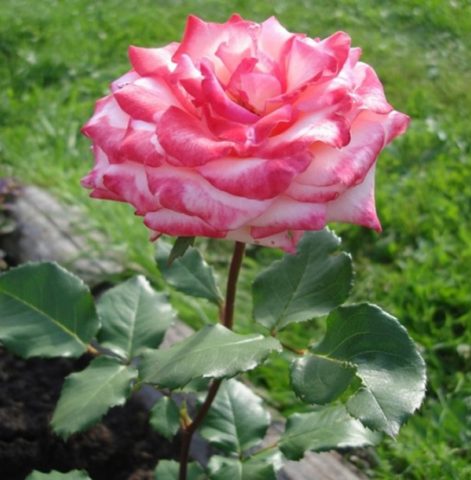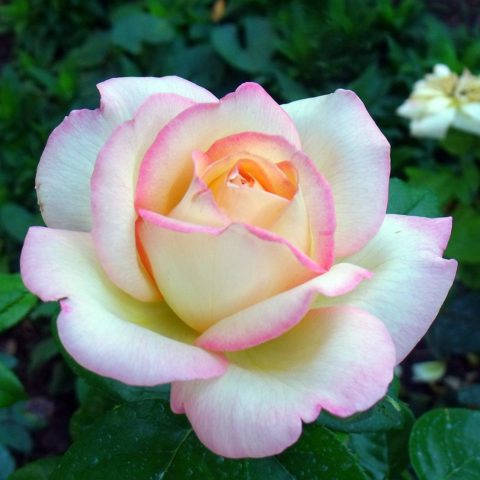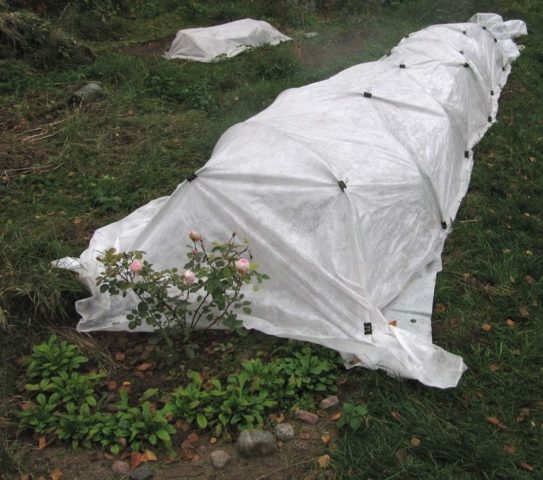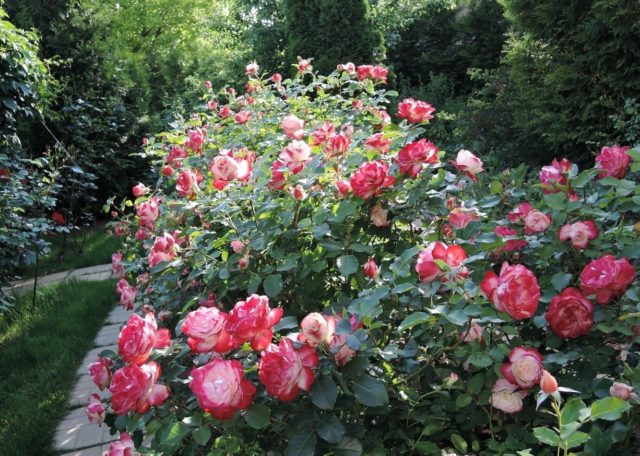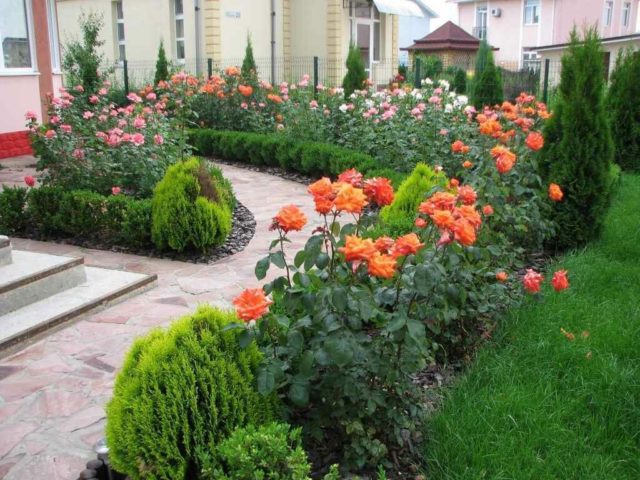Content
Rose Princess of Monaco is characterized by repeated long flowering. Due to the compact size of the bush, it belongs to the floribunda group. The Princess Monaco variety is a perennial plant with medium winter hardiness, which is common in the fifth climatic zone. In the Central and Middle regions, it requires shelter for the winter.
Breeding history
Rose Princess Monaco (Princesse De Monaco) - the result of French selection, Guyot is considered the originator of the variety. In the 60s of the XIX century, by hybridizing the tea and remontant groups, the breeder developed a new variety with repeated flowering. The rose was named Preference.
Many years later, the variety was renamed in honor of Princess Grace of Monaco, who recognized the rose as one of the best at an exhibition held by Meilland. In some reference books, the name of the organizer was included in the variety designation.
Description of Rose Princess of Monaco and characteristics
Hybrid Tea Rose Meilland is a heat-loving plant, but with proper shelter of the Princesses de Monaco, it can withstand temperatures as low as -28 0C. In the flower market, the variety is in demand not only for decorativeness, but also for stress resistance, unpretentious care. The Princess of Monaco is often found in the southern regions, the Moscow region and the Leningrad region.
Full vegetation is possible in a partially shaded area, protected from the influence of the north wind. In the midday heat, the flower bed with the culture should be in the shade.
The Princess of Monaco will grow on any kind of soil, the main requirement is slightly acidic soil. Light and fertile soil is most suitable. A permanently moist area located in the shade is not chosen for a rose. In such a place, the growing season of the Princess Monaco variety slows down, the plant does not resist fungal infections poorly. The culture will bloom, but the flowers will be small and single.
From the remontant variety, the rose inherited repeated flowering. The first buds appear in the third year of the growing season in June, the duration of the period is 25–30 days. The second wave, starting 20 days later on the shoots of the current season, is not inferior in abundance to the first, and continues until October.
Rose habitus floribunda Princess of Monaco:
- The plant forms a bush 75–85 cm high, 60–70 cm wide with numerous upright single stems without lateral branches.
- The crown of the Princess Monaco variety is thick, the leaf plates are located on long petioles of three pieces. Leaves are tough, dark green with a brown tint, leathery. The shape is rounded with a sharp top, the surface is glossy, the edges are finely toothed.
- The stems of the Princess Monaco variety are tough, not drooping, stiff, brown in color. Ends with single buds.
- The flowers are double, the core is cone-shaped, closed, opens only at the end of the life cycle. The petals are rounded, with wavy edges, dark cream with a pink edging. Flower width - 13 cm.
- The aroma of the Princess of Monaco is delicate, there are citrus notes.
Advantages and disadvantages of the variety
The variety has been cultivated for over 100 years, the rose is popular with gardeners, often found in gardens and in personal plots. The Princess of Monaco is characterized by the following qualities:
- does not require transplantation, fully blooms in one area within ten years;
- a small number of thorns. They are short, sparsely located;
- original color of large flowers;
- versatility. The variety is used for landscape decoration, grown for cutting;
- undemanding care;
- drought resistance;
- high survival rate of planting material;
- profuse flowering that lasts until autumn;
- compactness. The bush keeps its shape well;
- stable immunity.
The disadvantage of the variety is considered intolerance to excess ultraviolet radiation. At high humidity, flowers are blocked. The culture responds poorly to excess moisture in the soil. For abundant flowering, soil aeration and top dressing are required.
Reproduction methods
The variety is propagated in any way, except for dividing the bush. An adult rose does not respond well to transfer if the root system is disturbed. The Princess of Monaco gives the seeds, which are used to produce seedlings.

Collect material during the second budding from inflorescences that wilted first
Cynarodium is cut, separated, seeds are taken out, washed and dried. Sow in warm climates in open ground at the end of October. Cover with agrofibre for the winter. In the spring, the material is removed. The seeds germinate quickly. Their permanent place is determined for the next year. The transplant is carried out in the spring.
You can grow seedlings indoors. After collecting, the seeds are mixed with sand, moistened, put in a cloth and placed in the refrigerator. After 1.5 months, sprouts will appear. The laying of the material is carried out in November, 1-2 pcs. in small plastic containers or glasses.
The method of grafting is more often used. The material is harvested from green stems before budding.
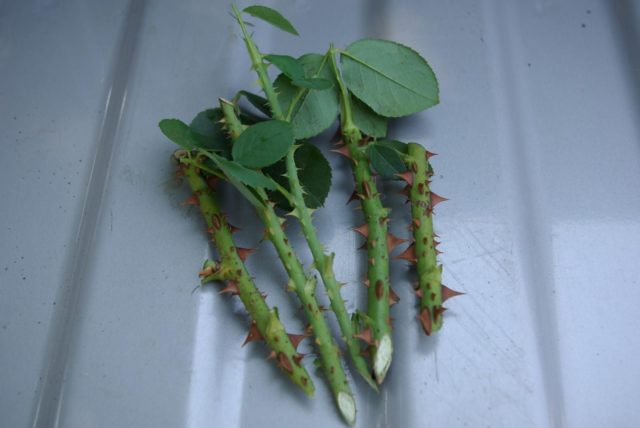
The sections are made at an angle and treated with a disinfectant.
Cuttings are determined in a nutrient substrate. In regions with low winter temperatures - in a container. For the winter, containers with rooted cuttings are brought into the room, seated in the spring. Next year, the Princess of Monaco will give her first buds.
You can propagate the rose by layering.
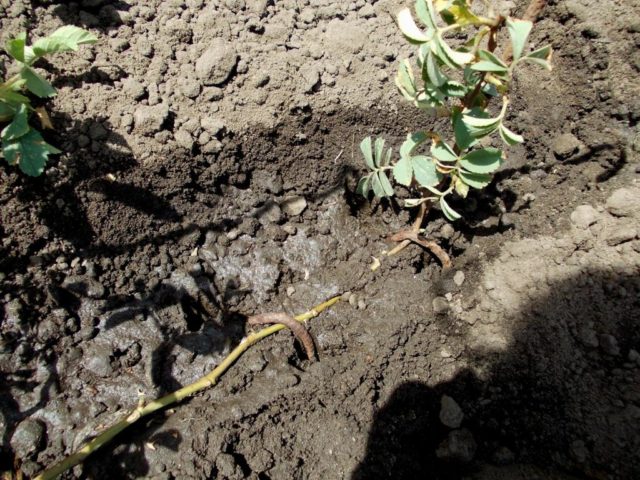
At the beginning of the season (before flowering), sprinkle the lower stem with soil
In the fall, the dug-in area is insulated so that the root processes do not freeze. In the spring, the stem is removed from the soil, the rooted areas are cut and planted
Growing and care
Hybrid tea varieties, which include the Princess of Monaco, are characterized by medium frost resistance. It is recommended to plant a rose on the site in the spring (April or May). Autumn planting is possible in subtropical climates. A hole is dug 10 cm wider than the root. The vaccination site should be covered by 3 cm.
Sequence of work:
- The rose root is placed in a solution of "Heteroauxin" for a day.
- The bottom of the depression is closed with a mixture of compost and peat with the addition of Agricola for flowering plants.
- The rose is placed in the center and covered with the rest of the fertile substrate. The stems are shortened, leaving 15–20 cm.
- The soil is compacted and watered.
Agricultural technology of the Princess of Monaco variety:
- Aeration of the soil is carried out as it is compacted.
- Weeds are removed by the roots.
- Watered at the rate of 30 liters of water for 8 days. You need to navigate by the precipitation in the region.
- It is recommended to mulch the rose with a mixture of peat and manure. The procedure is carried out after the stems have been shortened.
In the first year of growth, the rose is fertilized with liquid organic matter in early June. The main feeding is provided for the second and subsequent years of the growing season. In May and early July, nitrogen is introduced, from June to September - phosphorus, during budding and flowering, it is fertilized with potassium. If the soil is acidic, then calcium is added in the spring and autumn.
During the first and second flowering, "Agricola-Rose" is fed. The events end in early August.
Before winter, weak shoots are removed from the bush. Strong branches are cut to 60 cm. They are spudded, covered with straw or sawdust.
Pests and diseases
The Princess of Monaco does not pose any particular problems when growing due to its good immunity. If the rose is located in the correctly selected area, receives a sufficient amount of moisture and nutrition, then the plant does not get sick. Due to unfavorable weather conditions, such as a rainy, cold summer, the Princess of Monaco can suffer from powdery mildew. For preventive purposes, the rose is treated with copper sulfate before flowering. If a fungal infection manifests itself, then use "Topaz".
The following insects are parasitic on the rose:
- rose aphid. Fitoverm will help to get rid of it;
- click beetles. To combat them, use "Bazudin";
- spider mite. Treatment with colloidal sulfur is required;
- leaf roll. An effective remedy is "Agravertin".
At the end of the season, the root circle is shed with Iskra solution to destroy insects hibernating in the soil.
Application in landscape design
The hybrid tea group is considered the most common in gardens. The Princess of Monaco is an old variety, it is grown in summer cottages, used in urban landscaping. A medium-sized shrub suitable for any composition. The rose is combined with almost any crops, except for large-sized ones, which completely shade the site.
Basic design techniques using the Princess of Monaco rose:
- They create compositions in any corner of the garden from varieties with different colors.
- A rose is planted near the garden path for tamping decorative tall trees.
- They create rose gardens in color contrasts.
- Decorate recreation areas on the site.
- The Princess of Monaco is included in group plantings to create a two-tiered curb.
Conclusion
Rose Princess of Monaco is a perennial crop with long flowering. The French variety belongs to the floribunda group, which is characterized by repeated budding and large flowers. They use a rose in design and in floristry to compose bouquets.
Reviews with a photo about the rose princess of Monaco


